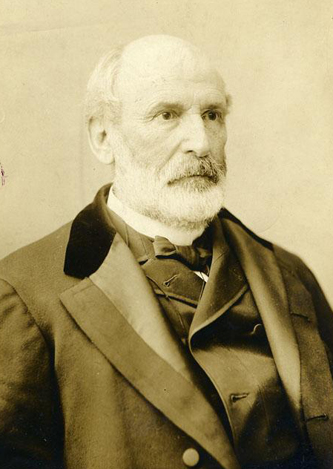Ransom, Matt[hew] Whitaker
8 Oct. 1826–8 Oct. 1904
![Photograph of Matt[hew] Whitaker Ransom, circa 1870-1880. Image from the Library of Congress. Photograph of Matt[hew] Whitaker Ransom, circa 1870-1880. Image from the Library of Congress.](/sites/default/files/images_bio/Ransom_Matthew_Whitaker_LoC_03967v.jpg) Matt[hew] Whitaker Ransom, Confederate soldier, North Carolina attorney general, and U.S. senator, was born in Warren County to Robert and Priscilla West Coffield Whitaker Ransom. He attended Warrenton Academy and was graduated from The University of North Carolina in 1847. Having studied law during his senior year, he was at once admitted to the bar and commenced practice in Warrenton. A Whig in politics, he was a presidential elector on the Scott-Graham ticket in 1852. The same year the state legislature, although under the control of the Democrats, elected the popular Ransom attorney general of North Carolina. Three years later, when the Know-Nothing party absorbed the Whigs in the state, he resigned his position and identified with the Democrats.
Matt[hew] Whitaker Ransom, Confederate soldier, North Carolina attorney general, and U.S. senator, was born in Warren County to Robert and Priscilla West Coffield Whitaker Ransom. He attended Warrenton Academy and was graduated from The University of North Carolina in 1847. Having studied law during his senior year, he was at once admitted to the bar and commenced practice in Warrenton. A Whig in politics, he was a presidential elector on the Scott-Graham ticket in 1852. The same year the state legislature, although under the control of the Democrats, elected the popular Ransom attorney general of North Carolina. Three years later, when the Know-Nothing party absorbed the Whigs in the state, he resigned his position and identified with the Democrats.
In the meantime, Ransom had married Martha Anne Exum of Northampton County on 19 Jan. 1853 and moved to Verona, her fine plantation on the Roanoke River. The couple had eight children, including Matthew W., Jr., Joseph E., George E., Esther, Patrick Exum, and Robert. Ransom represented Northampton County in the lower house of the state legislature from 1858 to 1861, and in the latter year he served as one of three commissioners selected by the legislature to visit the Confederate convention at Montgomery, Ala. At this time he was a strong Union man, but Abraham Lincoln's call for troops made him a secessionist. He entered the Confederate army as a private but was soon commissioned a lieutenant colonel in the First North Carolina state troops and subsequently a colonel of the Thirty-fifth North Carolina Regiment. This unit was a part of his younger brother Robert's brigade, which he later commanded. On 13 June 1863 he was promoted to the rank of brigadier general. Ransom participated in the Battles of Seven Pines, Malvern Hill, Sharpsburg, Plymouth,  and Drewry's Bluff and in the siege of Petersburg. Wounded three times during the war, he surrendered his command at Appomattox.
and Drewry's Bluff and in the siege of Petersburg. Wounded three times during the war, he surrendered his command at Appomattox.
At the close of hostilities Ransom returned to farming and the practice of law in North Carolina. In 1872 he won a seat in the U.S. Senate to succeed Zebulon B. Vance, who had been elected but denied his seat because of political disabilities. He served continuously until 1895. In Washington Ransom acquired considerable influence even though he seldom delivered formal speeches on the floor of the Senate. He was a leader in securing a peaceful settlement to the disputed presidential election of 1876. A fusion of Populists and Republicans in North Carolina brought about his defeat in 1895, but President Grover Cleveland at once appointed him minister to Mexico, a post he held for two years. Afterwards Ransom retired permanently to private life. He died on his seventy-eighth birthday and was buried on his estate, Verona.
This person enslaved and owned other people. Many Black and African people, their descendants, and some others were enslaved in the United States until the Thirteenth Amendment abolished slavery in 1865. It was common for wealthy landowners, entrepreneurs, politicians, institutions, and others to enslave other people and use enslaved labor during this period. To read more about the enslavement and transportation of African people to North Carolina, visit https://aahc.nc.gov/programs/africa-carolina-0. To read more about slavery and its history in North Carolina, visit https://www.ncpedia.org/slavery. - Government and Heritage Library, 2023
References:
Samuel A. Ashe, ed., Biographical History of North Carolina, vol. 1 (1905).
Biog. Dir. Amer. Cong. (1961).
Walter Clark, ed., Histories of the Several Regiments and Battalions from North Carolina, vol. 2 (1901).
DAB, vol. 15 (1934).
"M W Ransom." Slave Schedules of the Eighth Census of the United States. 1860. District 1, Northampton, North Carolina. Image 1 of 12. National Archives Microfilm Publication M653. Accessed March 22, 2023 from Familysearch.org.
Raleigh News and Observer, 9 Oct. 1904.
Ezra J. Warner, Generals in Gray (1959 [portrait]).
Who's Who in America, 1903–1905.
Additional Resources:
"Matt W. Ransom." N.C. Highway Historical Marker E-10, N.C. Office of Archives & History. https://www.ncdcr.gov/about/history/division-historical-resources/nc-highway-historical-marker-program/Markers.aspx?sp=Markers&k=Markers&sv=E-10 (accessed April 30, 2013).
"Ransom's Assault." N.C. Highway Historical Marker BBB-5, N.C. Office of Archives & History. https://www.ncdcr.gov/about/history/division-historical-resources/nc-highway-historical-marker-program/Markers.aspx?sp=Markers&k=Markers&sv=BBB-5 (accessed April 30, 2013).
"Ransom, Matt Whitaker, (1826 - 1904)." Biographical Directory of the United States Congress. Washington, D.C.: The Congress. http://bioguide.congress.gov/scripts/biodisplay.pl?index=R000062 (accessed April 30, 2013).
Matt W. Ransom Papers, 1845-1914 (bulk 1868-1904) (collection no. 02615). The Southern Historical Collection. Louis Round Wilson Special Collections Library. University of North Carolina at Chapel Hill. http://www.lib.unc.edu/mss/inv/r/Ransom,Matt_W.html (accessed April 30, 2013).
Image Credits:
"Photograph, Accession #: H.1958.14.11." Photograph. 1865-1880. North Carolina Museum of History.
"Hon. Matt Whitaker Ransom of N.C." Photograph. [between 1870 and 1880]. Brady-Handy Photograph Collection. Library of Congress. http://www.loc.gov/pictures/item/brh2003000642/PP/ (accessed April 30, 2013).
"Photograph, Accession #: H.19XX.318.47." Photograph. 1900. North Carolina Museum of History.
1 January 1994 | Barrett, John G.